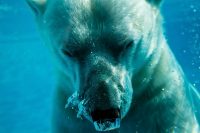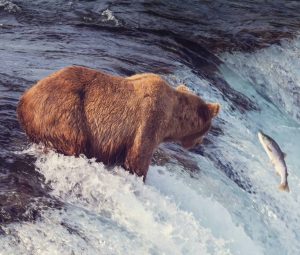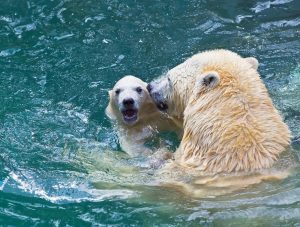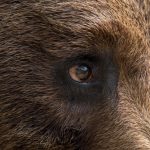Yes, all bears can swim. All 8 species of bears can swim, even the Giant Panda is a good swimmer.
Bears are fascinating and intelligent mammals that live in a variety of habitats across the globe. All of them live near water – and all of them can swim.
Can All Bears Swim Really Well?
Yes indeed – all 8 species of bear are known to be great swimmers – including the Giant Panda – who is normally thought of sitting in a jungle eating bamboo. Let’s look a bit closer for a better idea:
Polar Bear:

Polar bears – the largest of all the bears – are also the best swimmers. With their dependence on sea ice to hunt their favorite prey (seals) they are classed as marine mammals (like seals and sea lions) – and so are adapted well to the water. Coldwater too – they are still comfortable in temperatures as low as -50F out on the sea ice.
They are also incredibly strong and determined long-distance swimmers. Scientists recorded several individuals as having swum continually for up to 10 days straight! One even swam over 220 miles without stopping – but when the sea ice is melting – they have no choice.
Brown Bears & Black Bears:

These 3 species are found in vast forests with many wild rivers – we have all seen them hunting salmon on the TV.
They are also seen in catching other water-living prey like crustaceans, suckers, and fish spawn and spend quite a while in the water if they find a good spot!
To maintain a large home range they must also be able to cross large rivers – and swimming is the only way from one side to the other. These bears seem to love being in the water and are hugely confident with short swims and splashing about.
Sloth, Sun and Spectacled Bears:
Being more arboreal (tree-dwelling) these smaller species of bears often prefer more mountainous habitats. But, if there is water about, they are confident swimmers for sure.
If they need to move away from danger or start a new family – they won’t hesitate to cross water. Actually, Spectacled Bears are often seen actually playing in the water for fun with their pups.
Giant Pandas:
These well-loved bears aren’t usually the type of bear to be seen in water in their natural habitat – but they do love swimming. They don’t spend as much time in the water as other bears though – as marine life isn’t on the menu – what with them being mainly vegan and all.
In captivity – pandas absolutely love playing in their pools and splashing about. Whether cubs or adults – they all enjoy a good paddle – which would probably still be true if they were in the wild still?
Why Would Bears Need To Swim?

Their natural habitats – even those in the mountains – will have rivers and waterways crossing them. In the wet season in South America and Asia, new rivers appear or existing rivers get wider. Some bears in the north-west US are often seen along the beach and in the ocean.
As mentioned above – there are several main reasons why bears need to swim or cross these rivers on a regular basis – whether they want to or not:
- Searching for food – bears will walk great distances if food is in short supply – and often cross rivers to find something tasty
- Searching for a mate – bears need to breed and not even a raging river will stop them finding the right mate
- Looking for new home – grown-up bear cubs need to move away from mum and find their own spot to have to head off in all directions
- Escaping an enemy – not many animals hunt bears, but wolves will target bear cubs often – and angry male bears might be on the prowl
- Deforestation – add all of the above together when humans start encroaching on their land and destroying their homes…
Bears don’t suffer from being in the cold though. Their thick coats are designed in such a way that they dry very quickly and don’t stay wet – like human hair does after a swim. A quick dunk isn’t usually an issue. They usually shake off excess water really efficiently – their specially-designed hairs and layer of fat beneath the skin (thick blubber in Polar Bears) help them to stay warm too.
Swimming is an essential part of being a bear – so, can all bears swim? Absolutely YES they can!









